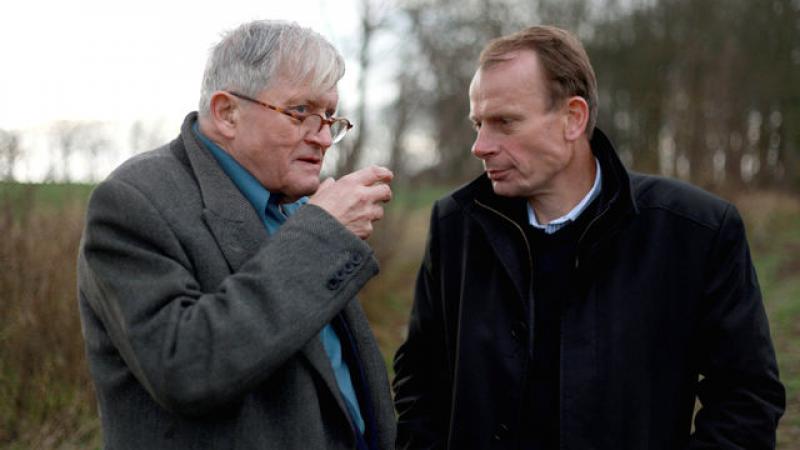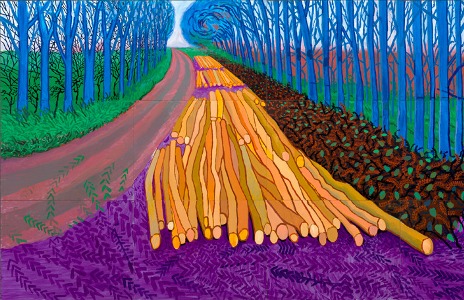David Hockney: The Art of Seeing, BBC Two | reviews, news & interviews
David Hockney: The Art of Seeing, BBC Two
David Hockney: The Art of Seeing, BBC Two
Hockney’s always good company, but Marr could have penetrated a little deeper

It’s hard to imagine a bad documentary on David Hockney. Hockney always gives good Hockney: the quotable sentences come thick and fast; his enthusiasm for his craft is never less than exhilarating, and like that other great British artist of his generation – Francis Bacon – he’s always been better at getting to the crux of why and how he makes pictures than any of his commentators have.
In last night’s Culture Show Special, the amicable Yorkshireman was gently quizzed by his friend, the journalist and broadcaster Andrew Marr. But what added a further dimension to proceedings was the fact that Marr himself is a painter. So rather than just go over ground covered countless times before by many previous interrogators, Marr refreshingly focused on the work itself. There was a nice moment, for example, when Marr homed in on a canvas that wasn’t meant to be judged in isolation (it was part of a huge landscape being reassembled on a wall of The Royal Academy) to point out, quite rightly in my judgment, that it was striking enough to be assessed as a work of art in its own right. I suspect few non-painting art critics would have had the instinct or nerve to make such a call.
Looking is what Hockney has always done best, these days rising at four in the morning to get in as much looking as possible
But the best moment of the programme came towards the end when Marr announced it was time for him and Hockney to shut up so that we, the viewers, could contemplate one of the artist’s recent multiple-camera landscape films in unprecedented silence. Even though 30 seconds is no time at all, in 21st-century telly terms it’s a lifetime. So it was a bold gesture that served its purpose, hinting at how immersive and hypnotic these neo-cubist experiments in optical perception are. (Though I do urge you to go and see them at the RA for the full widesceen, multiple-screen effect.)

Less gripping - at least visually - was the grey and beige Bridlington woodland through which Marr and Hockney seemed to saunter for hours. Its drabness bore little relation to the stained-glass intensity of the countless paintings and iPad drawings it has inspired. Hockney’s explanation for this disjuncture was twofold. Firstly, 30 years spent in LA – a place he once described as "perfect" because it had the energy of America but the climate of the Mediterranean – had heightened his colour awareness. And secondly, and perhaps more pertinently because it reflects Hockey’s robust work ethic, “You really have to look.” For looking is what Hockney has always done best, these days rising at four in the morning to get in as much looking as possible.
The other thing Hockney has always been good at is talking. So the main body of last night’s Culture Show consisted of Marr listening to Hockney as they strolled around the Royal Academy exhibition, Marr listening to Hockney in the countryside which inspired much of the work in the exhibition, and Marr listening to Hockney for a BBC radio interview a few months ago. The only problem was that I didn’t feel I knew the man any better at the end of this hour than I did at the beginning. Because Hockney appears to give so much his interviews, it’s easy to overlook what he actually holds back.
This becomes problematic because Hockney is an artist whose work is perceived by his detractors as being all about surface. Every painting is a modern jazz adventure, a joyful tangent tackled with barely suppressed excitement and vigour, rather than a further exploration of an already established technique and way of seeing. And yet Hockney’s paintings are sometimes so easy on the eye they could raise the suspicion that the man is not telling you something.
So is the spectre of mortality present in Hockney’s work (as it so clearly is in Lucian Freud’s)? The nearest Marr got to pursuing such a line of enquiry came when he suggested to the great man that the feltpen-bright Winter Timber looked “angry”. He failed to get out of Hockney any admission that its garishly acidic pallet might be in any way reflective of a rage against the dying light. Knowing Hockney (or knowing his approach to painting) it might have been nothing more than a simple experiment in turning up the contrast controls of his palette. So it would have been interesting if that Hockney surface had been penetrated at least once, even if only to find out why people, politics or personal reflection are of little concern to the man, at least in his work. Perhaps it’s time to see if that old Bragg/Bacon South Bank Show is available on YouTube.
Share this article
Add comment
The future of Arts Journalism
You can stop theartsdesk.com closing!
We urgently need financing to survive. Our fundraising drive has thus far raised £49,000 but we need to reach £100,000 or we will be forced to close. Please contribute here: https://gofund.me/c3f6033d
And if you can forward this information to anyone who might assist, we’d be grateful.

Subscribe to theartsdesk.com
Thank you for continuing to read our work on theartsdesk.com. For unlimited access to every article in its entirety, including our archive of more than 15,000 pieces, we're asking for £5 per month or £40 per year. We feel it's a very good deal, and hope you do too.
To take a subscription now simply click here.
And if you're looking for that extra gift for a friend or family member, why not treat them to a theartsdesk.com gift subscription?
more TV
 The Diplomat, Season 3, Netflix review - Ambassador Kate Wyler becomes America's Second Lady
Soapy transatlantic political drama keeps the Special Relationship alive
The Diplomat, Season 3, Netflix review - Ambassador Kate Wyler becomes America's Second Lady
Soapy transatlantic political drama keeps the Special Relationship alive
 The Perfect Neighbor, Netflix review - Florida found-footage documentary is a harrowing watch
Sundance winner chronicles a death that should have been prevented
The Perfect Neighbor, Netflix review - Florida found-footage documentary is a harrowing watch
Sundance winner chronicles a death that should have been prevented
 Murder Before Evensong, Acorn TV review - death comes to the picturesque village of Champton
The Rev Richard Coles's sleuthing cleric hits the screen
Murder Before Evensong, Acorn TV review - death comes to the picturesque village of Champton
The Rev Richard Coles's sleuthing cleric hits the screen
 Black Rabbit, Netflix review - grime and punishment in New York City
Jude Law and Jason Bateman tread the thin line between love and hate
Black Rabbit, Netflix review - grime and punishment in New York City
Jude Law and Jason Bateman tread the thin line between love and hate
 The Hack, ITV review - plodding anatomy of twin UK scandals
Jack Thorne's skill can't disguise the bagginess of his double-headed material
The Hack, ITV review - plodding anatomy of twin UK scandals
Jack Thorne's skill can't disguise the bagginess of his double-headed material
 Slow Horses, Series 5, Apple TV+ review - terror, trauma and impeccable comic timing
Jackson Lamb's band of MI5 misfits continues to fascinate and amuse
Slow Horses, Series 5, Apple TV+ review - terror, trauma and impeccable comic timing
Jackson Lamb's band of MI5 misfits continues to fascinate and amuse
 Coldwater, ITV1 review - horror and black comedy in the Highlands
Superb cast lights up David Ireland's cunning thriller
Coldwater, ITV1 review - horror and black comedy in the Highlands
Superb cast lights up David Ireland's cunning thriller
 Blu-ray: The Sweeney - Series One
Influential and entertaining 1970s police drama, handsomely restored
Blu-ray: The Sweeney - Series One
Influential and entertaining 1970s police drama, handsomely restored
 I Fought the Law, ITVX review - how an 800-year-old law was challenged and changed
Sheridan Smith's raw performance dominates ITV's new docudrama about injustice
I Fought the Law, ITVX review - how an 800-year-old law was challenged and changed
Sheridan Smith's raw performance dominates ITV's new docudrama about injustice
 The Paper, Sky Max review - a spinoff of the US Office worth waiting 20 years for
Perfectly judged recycling of the original's key elements, with a star turn at its heart
The Paper, Sky Max review - a spinoff of the US Office worth waiting 20 years for
Perfectly judged recycling of the original's key elements, with a star turn at its heart
 The Guest, BBC One review - be careful what you wish for
A terrific Eve Myles stars in addictive Welsh mystery
The Guest, BBC One review - be careful what you wish for
A terrific Eve Myles stars in addictive Welsh mystery
 theartsdesk Q&A: Suranne Jones on 'Hostage', power pants and politics
The star and producer talks about taking on the role of Prime Minister, wearing high heels and living in the public eye
theartsdesk Q&A: Suranne Jones on 'Hostage', power pants and politics
The star and producer talks about taking on the role of Prime Minister, wearing high heels and living in the public eye

Comments
Andrew Marr didn't comment on